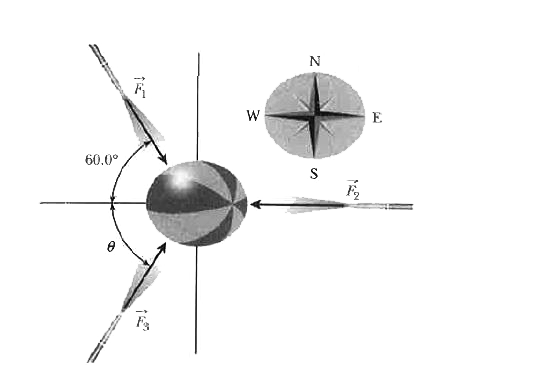Prove that under the action of three concurrent forces →F1,→F2, and →F3 , a body will be in equilibrium when →F1+→F2+→F3=0.
Text Solution
Consider three forces →F1,→F2, and →F3 acting at the same point O as shown as in the figure.
By parallelogram law, resultant of →F1 and →F2, is given by
→F=→F1+→F2
Body will be in equilibrium if →F3=−→F

Body will be in equilibrium if →F3=−→f
or →F3=−(→F1+→F2)
or →F1+→F2+→F3=→0
|
Updated on:21/07/2023
Similar Questions
Knowledge Check
- Question 1 - Select One
A body is under the action of three forces →F1,→F2and→F3. In which case the body cannot undergo angular acceleration ?
A−→F1,−→F2and−→F3 are concurrentB−→F1+−→F2+−→F3=0C−→F1,−→F2 is parallel to −→F3 but the three forces are not concurrentD−→F1and−→F2 act at the same point but −→F3 acts at different point. - Question 2 - Select One
A body is under the action of three forces →F1,→F2 and →F3. In which case the body cannot undergo angular acceleration ? .
A→F1,→F2 and →F3 are concurrent, point of concurrence beign centre of mass .B→F1+→F2+→F3=0C→F1,→F2 is parallel to →F3 but the three forces are not concurrent .D→F1 and →F2 act at the same point but →F3 acts at different point . - Question 3 - Select One
At a picnic, there is a contest in which hoses are used to shoot water at a beach ball from three directions. As a result, three forces act on the ball, →F1,→F2and→F3 (see the drawing). The magnitudes of →F1and→F2=50.0NandF2=90.0N. Using the graphical technique, determine the angle such that the resultant force acting on the ball is zero.
 A21∘B26∘C34∘D39∘
A21∘B26∘C34∘D39∘
The resultant of the forces →F1=4ˆi−3ˆj and →F2=6ˆi+8ˆj is
View SolutionA body is at rest under the action of three forces, two of which are →F1=4ˆi,→F2=6ˆj, the third force is
View SolutionThe resultant of the forces →F1=4ˆi−3ˆj and →F2=6ˆi+8ˆj is
View SolutionThree forces →F1,→F2 and →F3 are simultaneously acting on a particle of mass 'm' and keep it in equlibrium. If →F1 force is reversed in direction only, the acceleration of the particle will be.
View SolutionThree force F1=(3ˆi+2ˆj−ˆk) →F2 and that the particle may be in equilibrum , the value of 'a' is :
View Solution


